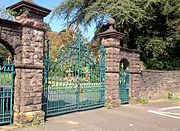Belle Vue Park
History
The land on which the park stands was a gift to Newport from Godfrey Morgan, 1st Viscount Tredegar in 1891 to provide a public park for its citizens. An open competition to design and construct the park was won by the Cumbrian landscape architect T. H. Mawson. Mawson's winning design was initially designed incorrectly for the neighbouring field, the site of the then Newport and Monmouthshire Hospital, after Mawson misunderstood directions on his first visit to Newport. The mistake was not realised until the first site visit, after the contract had been awarded. As a result, the designer had to promptly re-evaluate his plans for the present site. The park was Mawson's first win in an open competition. He went on to become one of the foremost landscape architects of his time, responsible for the design of many gardens in his adopted Lake District, including Holker Hall and Rydal Hall as well as Dyffryn Gardens near Cardiff. In November 1892 Lord Tredegar performed the ceremony of cutting the first sod; construction began and the park opened on 8 September 1894. The final cost of the park is recorded as £19,500.
Features
Belle Vue Park has many features typical of a Victorian public park, including the conservatories and pavilion, bandstand and rockeries. Additional features were added to the park throughout the years. The Gorsedd Stone Circle was erected in 1896, for the National Eisteddfod, held in Belle Vue Park in 1897. The bowling greens were opened in 1904 and a Tea House added in 1910. The bandstand and original series of cascades were restored in 2006.
Tearooms
Belle Vue Tearooms is a social enterprise café located near the Pavilion. It is run by Cotyledon BMCIC, a Machen-based community interest company who also operate rural markets across South East Wales, including a monthly food and craft market which is held on the first Sunday of every month throughout 2020 starting from Sunday 1 March 2020. The tea rooms are open daily (including Christmas Day) from 9am - 4pm serving drinks and meals showcasing produce from the market traders. Weddings can be held at the conservatories and the bandstand, the function room can also be hired for parties, baby showers, meetings, birthdays etc. The café was initially refurbished and opened by the Malpas based small business Parc Pantry, who handed back the premises to Newport City Council in 2018.
Flora
Belle Vue Park contains a number of rare specimens. In early Spring the Himalayan Magnolias produce huge goblet-shaped pink flowers and the branches of the Judas Trees can be seen covered with clusters of rose-lilac flowers in May. In June and July the Tulip Tree produces its distinctive orange tulip-shaped flowers. Autumn brings glorious leaf colour to many of the trees and shrubs. Of particular note are the clear yellow leaves of Ginkgo biloba, one of only four deciduous conifers that can be seen growing in the British Isles today, and the glorious crimson leaves of the Liquidambar, a native of the eastern United States.
Gallery
-
The Pavilion
-
The Tea House
-
Belle Vue Park gates, Cardiff Road, Newport
References
- ^ "Bellevue Park, Newport; Belle Vue Park, Newport (266093)". Coflein. RCAHMW. Retrieved 29 September 2021.
- ^ "Belle Vue Park · Newport NP20 2UB, United Kingdom".
- ^ Green Flag Awards - Belle Vue Park, Newport Archived 3 October 2008 at the Wayback Machine
- ^ Cadw. "Belle Vue Park (PGW(Gt)19(NPT))". National Historic Assets of Wales. Retrieved 6 February 2023.
- ^ "Belle Vue Park tearooms transformed by Newport duo". South Wales Argus. Retrieved 1 August 2019.
- ^ Knapman, Joshua (25 September 2018). "Council blamed as popular city tea rooms Parc Pantry set to close". walesonline. Retrieved 1 August 2019.


